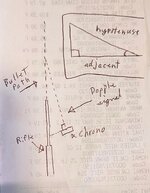An interesting anadote, perhaps a difference in pressure, perhaps an issue with the Garmin chronograph.
Yesterday morning for a zero check, I shot 10 rounds over @Marty Garmin, got a velocity of 2858 fps for 10 shots. Historically that load has gotten my 2700-2740 fps in temps very similar.
At the end of the day, and about 95 rounds later, I shot 14 rounds over my Garmin, average 2761 fps, max was 2826 fps.
I turned off my chrono, then Marty wanted to shoot a few rounds, so I turned it back on and he put 4 rounds over it (less than 5 minutes in between). These 4 averaged 2856 fps with a minimum velocity of 2830.
So, the 100 fps was not a difference between the chronographs.
My suspicion is that positioning of the Garmin made the difference, I need to go back and play with it.
All rounds were loaded in the same go a few weeks ago. It is a slightly compressed load, so no way to double fill and adding even 0.5 gr of powder takes it to very crunchy and needing a drop tube to avoid nose deformation. Plus, every powder charge is measured with the draft cover over the scale and rejected if off by 0.1 of a gr. So, I don't think it was the load.
But, it does have me wondering. I think what I really need to do is true velocity on the range and stop treating the chronograph as definitive. I've not done the math, but a doppler only measures movement towards or away from the source, so a slight angle will result in a slower reading. This is what I suspect caused the difference. But, does a few degrees of offset actually result in a 3-4% error?
I had better luck at extend range with the 2858 fps in my ballistics calculator, but with the variation in wind it is hard to say if that was actually due to elevation or just the little 77 TMK getting pushed around, I mean it was sub sonic prior to getting to the target in some cases.
I will get out to the range at some point and play with it, but probably not in the next month due to family obligations.
Yesterday morning for a zero check, I shot 10 rounds over @Marty Garmin, got a velocity of 2858 fps for 10 shots. Historically that load has gotten my 2700-2740 fps in temps very similar.
At the end of the day, and about 95 rounds later, I shot 14 rounds over my Garmin, average 2761 fps, max was 2826 fps.
I turned off my chrono, then Marty wanted to shoot a few rounds, so I turned it back on and he put 4 rounds over it (less than 5 minutes in between). These 4 averaged 2856 fps with a minimum velocity of 2830.
So, the 100 fps was not a difference between the chronographs.
My suspicion is that positioning of the Garmin made the difference, I need to go back and play with it.
All rounds were loaded in the same go a few weeks ago. It is a slightly compressed load, so no way to double fill and adding even 0.5 gr of powder takes it to very crunchy and needing a drop tube to avoid nose deformation. Plus, every powder charge is measured with the draft cover over the scale and rejected if off by 0.1 of a gr. So, I don't think it was the load.
But, it does have me wondering. I think what I really need to do is true velocity on the range and stop treating the chronograph as definitive. I've not done the math, but a doppler only measures movement towards or away from the source, so a slight angle will result in a slower reading. This is what I suspect caused the difference. But, does a few degrees of offset actually result in a 3-4% error?
I had better luck at extend range with the 2858 fps in my ballistics calculator, but with the variation in wind it is hard to say if that was actually due to elevation or just the little 77 TMK getting pushed around, I mean it was sub sonic prior to getting to the target in some cases.
I will get out to the range at some point and play with it, but probably not in the next month due to family obligations.

